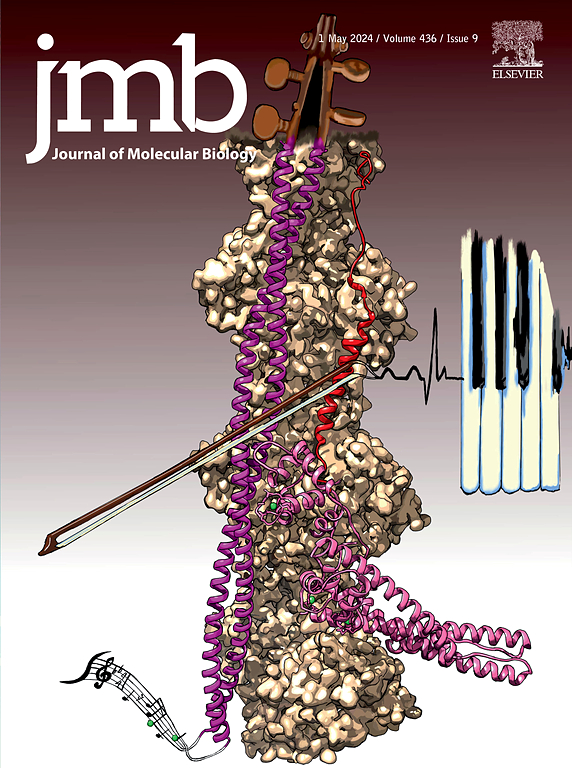Membrane Disruption Properties of Poly-Glycine Arginine Dipeptide Repeats Affected by Peptide Repeats Continuity and Membrane Composition
IF 4.5
2区 生物学
Q1 BIOCHEMISTRY & MOLECULAR BIOLOGY
引用次数: 0
Abstract
C9ORF72 hexanucleotide expansion is the most common genetic mutation in amyotrophic lateral sclerosis (ALS) and frontotemporal lobar degeneration (FTD). This expansion can be translated into dipeptide repeats (DPRs) through repeat-associated non-ATG (RAN) translation. Arginine-rich DPRs, i.e., poly-glycine arginine (poly-GR) and poly-proline arginine (poly-PR) are considered the most toxic ones among the five types of DPRs. We recently discovered that poly-GR forms helical conformation and is able to penetrate cell membranes, leading to cytotoxicity, but the mechanism remains unclear. Here, we investigated the membrane disruption mechanism of poly-GR related to its sequence and membrane composition. To test this, we stopped its continuously repeated sequence by inserting several proline residues to disrupt its helical structure. We found that the modification reduced its cytotoxicity and membrane disruption capability. Next, we examined the influence of lipid composition on the membrane-disrupting ability of poly-GR using various liposomes. Poly-GR caused higher leakage in the negatively charged liposomes compared to the neutral or positively charged ones. Cholesterol content affected the extent of disruption, while gangliosides had no significant effect. Using small-angle x-ray scattering (SAXS), total internal reflection fluorescence (TIRF) microscopy, and atomic force microscopy (AFM), we observed the behavior of poly-GR on lipid membranes. Finally, we directly treated mouse neuroblastoma to modulate the cholesterol content and found that cholesterol depletion inhibited the internalization of poly-GR into the cells and reduced cytotoxicity. These findings reveal that the conformation of poly-GR and the lipid composition influence its membrane penetration, offering insights into potential therapeutic strategies for C9ORF72-related diseases.

聚甘氨酸精氨酸二肽重复序列的破膜特性受肽重复序列连续性和膜组成的影响。
C9ORF72六核苷酸扩增是肌萎缩性侧索硬化症(ALS)和额颞叶变性(FTD)中最常见的基因突变。这种扩增可以通过重复序列相关的非atg (RAN)翻译翻译成二肽重复序列(DPRs)。富含精氨酸的DPRs,即聚甘氨酸精氨酸(poly-GR)和聚脯氨酸精氨酸(poly-PR)被认为是五种DPRs中毒性最大的。我们最近发现poly-GR形成螺旋构象,能够穿透细胞膜,导致细胞毒性,但其机制尚不清楚。本文研究了聚gr的破膜机理及其与膜组成的关系。为了验证这一点,我们通过插入几个脯氨酸残基来破坏其螺旋结构来停止其连续重复序列。我们发现这种修饰降低了它的细胞毒性和破坏膜的能力。接下来,我们使用各种脂质体检测了脂质组成对聚gr膜破坏能力的影响。与带中性或带正电的脂质体相比,带负电的聚gr脂质体的渗漏率更高。胆固醇含量影响破坏程度,而神经节苷类没有显著影响。利用小角x射线散射(SAXS)、全内反射荧光(TIRF)显微镜和原子力显微镜(AFM)观察了聚gr在脂质膜上的行为。最后,我们直接处理小鼠神经母细胞瘤来调节胆固醇含量,发现胆固醇的消耗抑制了多聚gr内化到细胞中,降低了细胞毒性。这些发现表明poly-GR的构象和脂质组成影响其膜渗透,为c9orf72相关疾病的潜在治疗策略提供了见解。
本文章由计算机程序翻译,如有差异,请以英文原文为准。
求助全文
约1分钟内获得全文
求助全文
来源期刊

Journal of Molecular Biology
生物-生化与分子生物学
CiteScore
11.30
自引率
1.80%
发文量
412
审稿时长
28 days
期刊介绍:
Journal of Molecular Biology (JMB) provides high quality, comprehensive and broad coverage in all areas of molecular biology. The journal publishes original scientific research papers that provide mechanistic and functional insights and report a significant advance to the field. The journal encourages the submission of multidisciplinary studies that use complementary experimental and computational approaches to address challenging biological questions.
Research areas include but are not limited to: Biomolecular interactions, signaling networks, systems biology; Cell cycle, cell growth, cell differentiation; Cell death, autophagy; Cell signaling and regulation; Chemical biology; Computational biology, in combination with experimental studies; DNA replication, repair, and recombination; Development, regenerative biology, mechanistic and functional studies of stem cells; Epigenetics, chromatin structure and function; Gene expression; Membrane processes, cell surface proteins and cell-cell interactions; Methodological advances, both experimental and theoretical, including databases; Microbiology, virology, and interactions with the host or environment; Microbiota mechanistic and functional studies; Nuclear organization; Post-translational modifications, proteomics; Processing and function of biologically important macromolecules and complexes; Molecular basis of disease; RNA processing, structure and functions of non-coding RNAs, transcription; Sorting, spatiotemporal organization, trafficking; Structural biology; Synthetic biology; Translation, protein folding, chaperones, protein degradation and quality control.
 求助内容:
求助内容: 应助结果提醒方式:
应助结果提醒方式:


